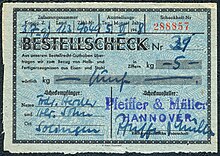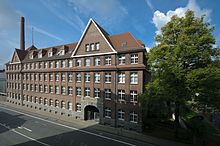Friedrich Herder Abraham son
| Friedrich Herder Abraham son
|
|
|---|---|
| legal form | GmbH |
| founding | February 27, 1727 |
| Seat | Solingen , Germany |
| Branch | Cutlery |
| Website | www.herder-solingen.de |
The company Friedrich Herder Abraham Sohn GmbH is a cutlery company from Solingen . It is active both domestically and heavily in export. One of the company's trademarks has been “ Ace of Spades ” since 1727 .
history

The company was founded on February 27, 1727. On this day, Peter Herder zu Pilghausen had the trademark “Schoppenass” (= “Pik As”) registered in the drawing roll of the Solingen “Messmachergericht”. The certificate about this is still preserved in the Solingen city archive. The fork symbol and the cross-shaped double key were added later.
After Peter Herder's death in 1762, the company, which at that time was already exporting to the Dutch market, was transferred to the sons Abraham and Johann Peter Herder. They were followed by the eldest son Abraham Herder, Johann Abraham Herder, born in 1761. When he gave his sons a share in the business, he called the company “Joh. Abr. Herder & Sne ”. After his son Abraham died, Johann Abraham Herder took on his grandson Friedrich Herder as a partner in 1839 - shortly before his own death - and from 1841 he ran the company under the name “Friedrich Herder Abr. Son ”continues. The company has kept this name to this day, even if there are no Herders among its owners today.
After Friedrich Herder's death in 1887, Gustav Weyersberg took over management of the company. He was the eldest son from the first marriage of Friedrich Herder's daughter, Emilie, with Hermann Weyersberg. The younger son Carl Weyersberg took over the management of the newly established branch in Buenos Aires in 1908 together with Hermann Bick, the son of Emilie Herder's second marriage with the Solingen pastor Bick. These led the company until it was continued in 1993 by businessmen Hans Joachim Röllecke and Detlef Weides from bankruptcy as "Friedrich Herder Abraham Sohn GmbH".
Location
The company's location was initially a residential and commercial building in Obenpilghausen. In 1859 a residential building was built on what is now Grünewalder Strasse, later production facilities and, in 1913, the still-preserved administration building opposite the JA Henckels company . In 1995 the production and administration rooms were relocated to the company building on Obenitterstrasse.
The markets
In its traditional business, knife and scissors production , the company was strongly export-oriented. The main sales markets were the Netherlands and Belgium . In addition, since the end of the 19th century, overseas markets have also been opened up, especially in the colonial areas of Asia ( Dutch East Indies ) and, since 1908, South America , especially Argentina . At the height of its development, Herder employed around 450 factory workers and salaried employees and about the same number of home workers . The company has remained a manageable and conservative family business to this day , which apart from starting the production of closed- die forgings, could not bring itself to any further diversification. In 1993, the company finally had nothing to counter the increasing price competition in its traditional markets towards the end of the 20th century: it filed for bankruptcy and was then continued as a GmbH.
Factory building listed
Today the former “cutlery factory and drop forge Friedrich Herder Abr. Sohn “a listed building complex at Grünewalder Strasse 29 in Solingen- Höhscheid .
Only the buildings designed by Hermann vom Endt (1861–1939) remain from the factory . The four-storey brick-built office building from 1911 to 1913 has both neo-classical elements ( risalites , pilaster strips ) and forms of the Heimat style ( hipped roofs , white wooden cornices on eaves and gables). The natural stone cladding on the ground floor continues in the enclosure wall of the factory premises.
The historically significant company building serves as a technology center for Solingen's economic development agency .
literature
- Albert Weyersberg: The Solingen Herder . In: The home. 7th year 1931.
- Franz Hendrichs: Friedr. Herder Abr. Son, Solingen. Festschrift on the occasion of the 200th anniversary. Solingen, 1927.
- Uwe Vetter: The "Schoppen-As" is 260 years old . In: Solinger Morgenpost. May 21, 1987.
- Herbert Weber: That was "Schöppen-As" - The Friedr. Herder Abr. Son . In: Solinger Tageblatt . June 25, 1994.
- Georg Dehio : Handbook of the German art monuments, Rhineland. Deutscher Kunstverlag 2005, p. 1113.


